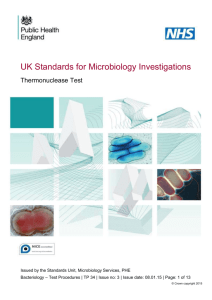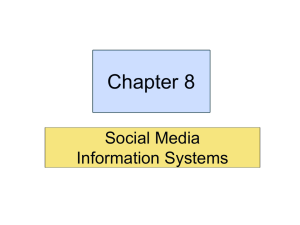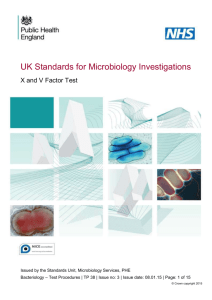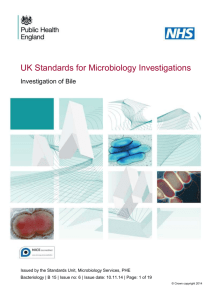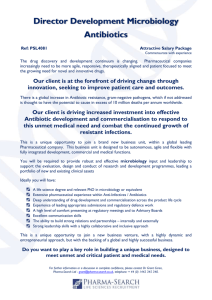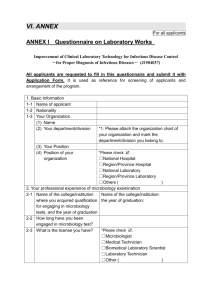TP 5i3 November 2014
advertisement
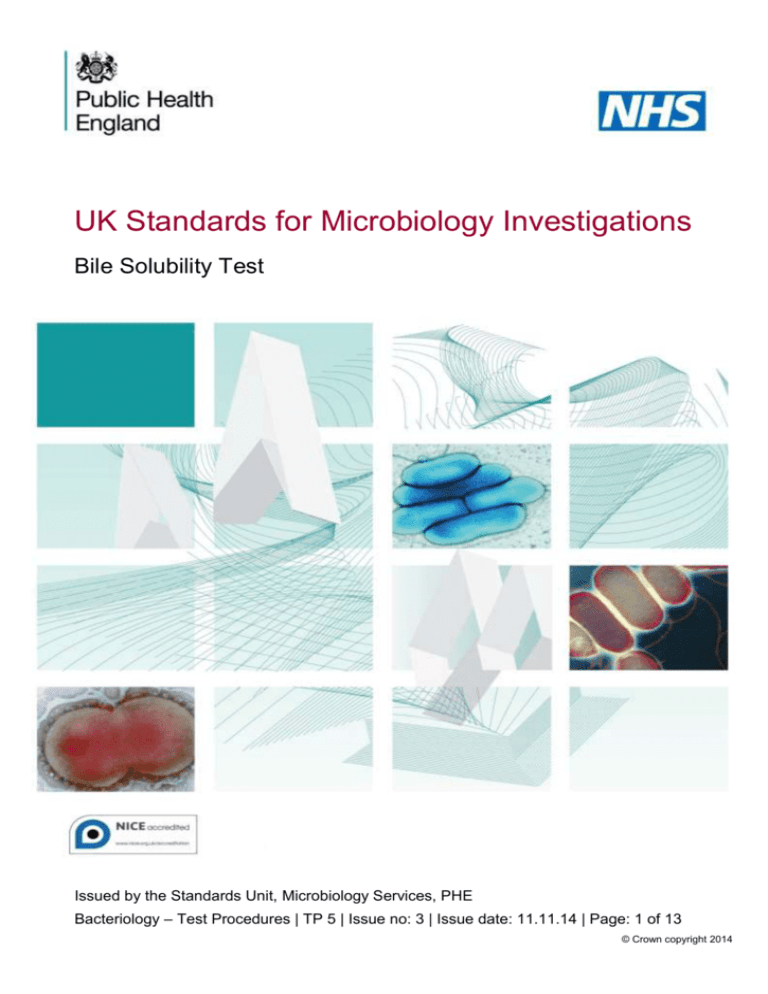
UK Standards for Microbiology Investigations Bile Solubility Test Issued by the Standards Unit, Microbiology Services, PHE Bacteriology – Test Procedures | TP 5 | Issue no: 3 | Issue date: 11.11.14 | Page: 1 of 13 © Crown copyright 2014 Bile Solubility Test Acknowledgments UK Standards for Microbiology Investigations (SMIs) are developed under the auspices of Public Health England (PHE) working in partnership with the National Health Service (NHS), Public Health Wales and with the professional organisations whose logos are displayed below and listed on the website https://www.gov.uk/ukstandards-for-microbiology-investigations-smi-quality-and-consistency-in-clinicallaboratories. SMIs are developed, reviewed and revised by various working groups which are overseen by a steering committee (see https://www.gov.uk/government/groups/standards-for-microbiology-investigationssteering-committee). The contributions of many individuals in clinical, specialist and reference laboratories who have provided information and comments during the development of this document are acknowledged. We are grateful to the Medical Editors for editing the medical content. For further information please contact us at: Standards Unit Microbiology Services Public Health England 61 Colindale Avenue London NW9 5EQ E-mail: standards@phe.gov.uk Website: https://www.gov.uk/uk-standards-for-microbiology-investigations-smi-qualityand-consistency-in-clinical-laboratories UK Standards for Microbiology Investigations are produced in association with: Logos correct at time of publishing. Bacteriology – Test Procedures | TP 5 | Issue no: 3 | Issue date: 11.11.14 | Page: 2 of 13 UK Standards for Microbiology Investigations | Issued by the Standards Unit, Public Health England Bile Solubility Test Contents ACKNOWLEDGMENTS .......................................................................................................... 2 CONTENTS ............................................................................................................................. 3 AMENDMENT TABLE ............................................................................................................. 4 UK STANDARDS FOR MICROBIOLOGY INVESTIGATIONS: SCOPE AND PURPOSE ....... 5 SCOPE OF DOCUMENT ......................................................................................................... 8 INTRODUCTION ..................................................................................................................... 8 TECHNICAL INFORMATION/LIMITATIONS ........................................................................... 8 1 SAFETY CONSIDERATIONS ...................................................................................... 9 2 REAGENTS AND EQUIPMENT ................................................................................... 9 3 QUALITY CONTROL ORGANISMS ............................................................................ 9 4 PROCEDURE AND RESULTS..................................................................................... 9 APPENDIX: BILE SOLUBILITY TEST .................................................................................. 11 REFERENCES ...................................................................................................................... 12 Bacteriology – Test Procedures | TP 5 | Issue no: 3 | Issue date: 11.11.14 | Page: 3 of 13 UK Standards for Microbiology Investigations | Issued by the Standards Unit, Public Health England Bile Solubility Test Amendment Table Each SMI method has an individual record of amendments. The current amendments are listed on this page. The amendment history is available from standards@phe.gov.uk. New or revised documents should be controlled within the laboratory in accordance with the local quality management system. Amendment No/Date. 6/11.11.14 Issue no. discarded. 2.3 Insert Issue no. 3 Section(s) involved Amendment Whole document. Hyperlinks updated to gov.uk. Page 2. Updated logos added. Introduction. This section have been reviewed and updated with references. Technical information/limitations. This section has been updated with useful information on Bile Solubility testing. Bacteriology – Test Procedures | TP 5 | Issue no: 3 | Issue date: 11.11.14 | Page: 4 of 13 UK Standards for Microbiology Investigations | Issued by the Standards Unit, Public Health England Bile Solubility Test UK Standards for Microbiology Investigations: Scope and Purpose Users of SMIs SMIs are primarily intended as a general resource for practising professionals operating in the field of laboratory medicine and infection specialties in the UK. SMIs provide clinicians with information about the available test repertoire and the standard of laboratory services they should expect for the investigation of infection in their patients, as well as providing information that aids the electronic ordering of appropriate tests. SMIs provide commissioners of healthcare services with the appropriateness and standard of microbiology investigations they should be seeking as part of the clinical and public health care package for their population. Background to SMIs SMIs comprise a collection of recommended algorithms and procedures covering all stages of the investigative process in microbiology from the pre-analytical (clinical syndrome) stage to the analytical (laboratory testing) and post analytical (result interpretation and reporting) stages. Syndromic algorithms are supported by more detailed documents containing advice on the investigation of specific diseases and infections. Guidance notes cover the clinical background, differential diagnosis, and appropriate investigation of particular clinical conditions. Quality guidance notes describe laboratory processes which underpin quality, for example assay validation. Standardisation of the diagnostic process through the application of SMIs helps to assure the equivalence of investigation strategies in different laboratories across the UK and is essential for public health surveillance, research and development activities. Equal Partnership Working SMIs are developed in equal partnership with PHE, NHS, Royal College of Pathologists and professional societies. The list of participating societies may be found at https://www.gov.uk/uk-standards-formicrobiology-investigations-smi-quality-and-consistency-in-clinical-laboratories. Inclusion of a logo in an SMI indicates participation of the society in equal partnership and support for the objectives and process of preparing SMIs. Nominees of professional societies are members of the Steering Committee and Working Groups which develop SMIs. The views of nominees cannot be rigorously representative of the members of their nominating organisations nor the corporate views of their organisations. Nominees act as a conduit for two way reporting and dialogue. Representative views are sought through the consultation process. SMIs are developed, reviewed and updated through a wide consultation process. Microbiology is used as a generic term to include the two GMC-recognised specialties of Medical Microbiology (which includes Bacteriology, Mycology and Parasitology) and Medical Virology. Bacteriology – Test Procedures | TP 5 | Issue no: 3 | Issue date: 11.11.14 | Page: 5 of 13 UK Standards for Microbiology Investigations | Issued by the Standards Unit, Public Health England Bile Solubility Test Quality Assurance NICE has accredited the process used by the SMI Working Groups to produce SMIs. The accreditation is applicable to all guidance produced since October 2009. The process for the development of SMIs is certified to ISO 9001:2008. SMIs represent a good standard of practice to which all clinical and public health microbiology laboratories in the UK are expected to work. SMIs are NICE accredited and represent neither minimum standards of practice nor the highest level of complex laboratory investigation possible. In using SMIs, laboratories should take account of local requirements and undertake additional investigations where appropriate. SMIs help laboratories to meet accreditation requirements by promoting high quality practices which are auditable. SMIs also provide a reference point for method development. The performance of SMIs depends on competent staff and appropriate quality reagents and equipment. Laboratories should ensure that all commercial and in-house tests have been validated and shown to be fit for purpose. Laboratories should participate in external quality assessment schemes and undertake relevant internal quality control procedures. Patient and Public Involvement The SMI Working Groups are committed to patient and public involvement in the development of SMIs. By involving the public, health professionals, scientists and voluntary organisations the resulting SMI will be robust and meet the needs of the user. An opportunity is given to members of the public to contribute to consultations through our open access website. Information Governance and Equality PHE is a Caldicott compliant organisation. It seeks to take every possible precaution to prevent unauthorised disclosure of patient details and to ensure that patient-related records are kept under secure conditions. The development of SMIs are subject to PHE Equality objectives https://www.gov.uk/government/organisations/public-health-england/about/equalityand-diversity. The SMI Working Groups are committed to achieving the equality objectives by effective consultation with members of the public, partners, stakeholders and specialist interest groups. Legal Statement Whilst every care has been taken in the preparation of SMIs, PHE and any supporting organisation, shall, to the greatest extent possible under any applicable law, exclude liability for all losses, costs, claims, damages or expenses arising out of or connected with the use of an SMI or any information contained therein. If alterations are made to an SMI, it must be made clear where and by whom such changes have been made. The evidence base and microbial taxonomy for the SMI is as complete as possible at the time of issue. Any omissions and new material will be considered at the next review. These standards can only be superseded by revisions of the standard, legislative action, or by NICE accredited guidance. SMIs are Crown copyright which should be acknowledged where appropriate. Bacteriology – Test Procedures | TP 5 | Issue no: 3 | Issue date: 11.11.14 | Page: 6 of 13 UK Standards for Microbiology Investigations | Issued by the Standards Unit, Public Health England Bile Solubility Test Suggested Citation for this Document Public Health England. (2014). Bile Solubility Test. UK Standards for Microbiology Investigations. TP 5 Issue 3. https://www.gov.uk/uk-standards-for-microbiologyinvestigations-smi-quality-and-consistency-in-clinical-laboratories Bacteriology – Test Procedures | TP 5 | Issue no: 3 | Issue date: 11.11.14 | Page: 7 of 13 UK Standards for Microbiology Investigations | Issued by the Standards Unit, Public Health England Bile Solubility Test Scope of Document The test is used specifically to presumptively differentiate between Streptococcus pneumoniae (bile soluble) and other α-haemolytic streptococci (not bile soluble). This SMI should be used in conjunction with other SMIs. Introduction The bile solubility test is used to determine the ability of bacterial cells to lyse in the presence of bile salts, within a specified time and temperature1. S. pneumoniae possesses an autolytic enzyme, an amidase, which lyses the cell’s own wall during division. The addition of bile salts (sodium deoxycholate) activates the autolytic enzyme and the organisms rapidly autolyse. Other α-haemolytic streptococci do not possess such an active system and therefore do not dissolve in bile. The bile solubility test may be performed in two different ways: using a cell suspension or by applying the Bile solubility Reagent directly to the colony. Technical Information/Limitations The test should not be performed on old cultures, as the active enzyme may be lost but rather on young, viable cells. Therefore, colonies resembling S. pneumoniae which are not bile soluble should be further identified using another method 2. Additional tests are recommended for incompletely lysed strains of S. pneumoniae. Normal autolysis of S. pneumoniae may be inhibited by a high concentration of bile salts being used. Evaporation may cause the reagent to become more concentrated, therefore affecting the test. When performing the bile solubility tube test using saline or unbuffered broth, it is essential to adjust the pH to neutral before adding the reagent in order to avoid false negative reactions. When testing using the plate method, care must be taken not to dislodge the colony being tested, therefore leading to false positive results. Place a drop of the Bile Solubility Reagent on the chosen circled colony. Care should be taken when working with colonies which are not mucoid as they may give false negative results using the direct colony method. Bacteriology – Test Procedures | TP 5 | Issue no: 3 | Issue date: 11.11.14 | Page: 8 of 13 UK Standards for Microbiology Investigations | Issued by the Standards Unit, Public Health England Bile Solubility Test Safety Considerations3-19 1 Refer to current guidance on the safe handling of all organisms and reagents documented in this SMI. All work likely to generate aerosols must be performed in a microbiological safety cabinet. The above guidance should be supplemented with local COSHH and risk assessments. Compliance with postal and transport regulations is essential. 2 Reagents and Equipment Colony procedure1: 2% solution of sodium deoxycholate in water and pure colonies on either a blood or chocolate agar plate. Broth procedure20: 10% solution of sodium deoxycholate in water and 0.85% solution of sodium chloride in water. Bacteriological straight wire/loop (preferably nichrome) or disposable alternative. 3 Quality Control Organisms Positive Control Streptococcus pneumoniae NCTC 12977 Negative Control Streptococcus mitis NCTC 10712 Note: These strains have been validated by NCTC to give this result. 4 Procedure and Results 4.1 Colony procedure1 This method works well on large or mucoid colonies, results on other colonies may be more subjective Select a well-isolated single colony from a blood or chocolate agar plate. Circle the colony on the bottom of the Petri dish. This will help locate it after testing Place one drop of 2% sodium deoxycholate directly on the colony. Incubate at 37°C for up to 30 min. Do not invert the plate. The lid may be left slightly ajar to aid evaporation When the reagent has dried examine the area for lysis or disintegration of the original colony Positive Result Disintegration of the colony and/or the appearance of a haemolytic zone in the medium where the colony was located Bacteriology – Test Procedures | TP 5 | Issue no: 3 | Issue date: 11.11.14 | Page: 9 of 13 UK Standards for Microbiology Investigations | Issued by the Standards Unit, Public Health England Bile Solubility Test Negative Result No change 4.2 Broth procedure20 Prepare a heavy suspension of a pure culture in 1.0mL of 0.85% saline. Divide the suspension between two tubes (one test and one control). Add 0.5mL of 10% sodium deoxycholate to the test suspension and 0.5mL of 0.85% saline to the control. Gently mix both suspensions and incubate at 37°C for up to 15 min. Examine for evidence of clearing of turbidity in the tube marked test compared with the saline control. Positive Result Suspension clears in tube labelled test and remains turbid in control tube Negative Result Suspension remains turbid in both tubes Note: Partial clearing (partial solubility) is not considered positive for S. pneumoniae identification. Bacteriology – Test Procedures | TP 5 | Issue no: 3 | Issue date: 11.11.14 | Page: 10 of 13 UK Standards for Microbiology Investigations | Issued by the Standards Unit, Public Health England Bile Solubility Test Appendix: Bile Solubility Test Large or mucoid colony from pure culture Broth procedure Colony procedure Prepare a heavy suspension of a pure culture in 1.0mL of 0.85% saline. Split evenly into two tubes Place one drop of 2% sodium deoxycholate directly on colony Inoculate at 37°C for up to 30 min Add 0.5mL of 10% sodium deoxycholate (test ) Add 0.5mL of 0.85% saline (control) Examine plate Mix and Incubate at 37°C for 15 min at the same time Positive Suspension clears Positive Colony lysed or disintegrated Negative No change Negative Suspension remains turbid Note: Positive Control: Streptococcus pneumoniae NCTC 12977 Negative Control: Streptococcus mitis NCTC 10712 The flowchart is for guidance only. Bacteriology – Test Procedures | TP 5 | Issue no: 3 | Issue date: 11.11.14 | Page: 11 of 13 UK Standards for Microbiology Investigations | Issued by the Standards Unit, Public Health England Bile Solubility Test References 1. MacFaddin JF. Bile Solubility Test. Biochemical Tests for Identification of Medical Bacteria. 3rd ed. Philadelphia: Lippincott Williams and Wilkins; 2000. p. 27-34. 2. Murray PR. Modification of the bile solubility test for rapid identification of Streptococcus pneumoniae. J Clin Microbiol 1979;9:290-1. 3. European Parliament. UK Standards for Microbiology Investigations (SMIs) use the term "CE marked leak proof container" to describe containers bearing the CE marking used for the collection and transport of clinical specimens. The requirements for specimen containers are given in the EU in vitro Diagnostic Medical Devices Directive (98/79/EC Annex 1 B 2.1) which states: "The design must allow easy handling and, where necessary, reduce as far as possible contamination of, and leakage from, the device during use and, in the case of specimen receptacles, the risk of contamination of the specimen. The manufacturing processes must be appropriate for these purposes". 4. Official Journal of the European Communities. Directive 98/79/EC of the European Parliament and of the Council of 27 October 1998 on in vitro diagnostic medical devices. 7-12-1998. p. 1-37. 5. Health and Safety Executive. Safe use of pneumatic air tube transport systems for pathology specimens. 9/99. 6. Department for transport. Transport of Infectious Substances, 2011 Revision 5. 2011. 7. World Health Organization. Guidance on regulations for the Transport of Infectious Substances 2013-2014. 2012. 8. Home Office. Anti-terrorism, Crime and Security Act. 2001 (as amended). 9. Advisory Committee on Dangerous Pathogens. The Approved List of Biological Agents. Health and Safety Executive. 2013. p. 1-32 10. Advisory Committee on Dangerous Pathogens. Infections at work: Controlling the risks. Her Majesty's Stationery Office. 2003. 11. Advisory Committee on Dangerous Pathogens. Biological agents: Managing the risks in laboratories and healthcare premises. Health and Safety Executive. 2005. 12. Advisory Committee on Dangerous Pathogens. Biological Agents: Managing the Risks in Laboratories and Healthcare Premises. Appendix 1.2 Transport of Infectious Substances Revision. Health and Safety Executive. 2008. 13. Centers for Disease Control and Prevention. Guidelines for Safe Work Practices in Human and Animal Medical Diagnostic Laboratories. MMWR Surveill Summ 2012;61:1-102. 14. Health and Safety Executive. Control of Substances Hazardous to Health Regulations. The Control of Substances Hazardous to Health Regulations 2002. 5th ed. HSE Books; 2002. 15. Health and Safety Executive. Five Steps to Risk Assessment: A Step by Step Guide to a Safer and Healthier Workplace. HSE Books. 2002. 16. Health and Safety Executive. A Guide to Risk Assessment Requirements: Common Provisions in Health and Safety Law. HSE Books. 2002. 17. Health Services Advisory Committee. Safe Working and the Prevention of Infection in Clinical Laboratories and Similar Facilities. HSE Books. 2003. Bacteriology – Test Procedures | TP 5 | Issue no: 3 | Issue date: 11.11.14 | Page: 12 of 13 UK Standards for Microbiology Investigations | Issued by the Standards Unit, Public Health England Bile Solubility Test 18. British Standards Institution (BSI). BS EN12469 - Biotechnology - performance criteria for microbiological safety cabinets. 2000. 19. British Standards Institution (BSI). BS 5726:2005 - Microbiological safety cabinets. Information to be supplied by the purchaser and to the vendor and to the installer, and siting and use of cabinets. Recommendations and guidance. 24-3-2005. p. 1-14 20. Isenberg HD, editor. Clinical Microbiology Procedures Handbook. Washington DC: American Society for Microbiology; 1992. p. 1.20.19-1.20.20 Bacteriology – Test Procedures | TP 5 | Issue no: 3 | Issue date: 11.11.14 | Page: 13 of 13 UK Standards for Microbiology Investigations | Issued by the Standards Unit, Public Health England

